Convective Properties and Lightning Activity in Different Categories of Thunderstorms over the Beijing Area during Five Warm Seasons
Abstract
1. Introduction
2. Data and Methodology
2.1. Study Region
2.2. Beijing Broadband Lightning Network
2.3. Radar Data
2.4. Other Meteorological Data
2.5. Thunderstorm Identification and Definition
3. Results
3.1. The Characteristics of Thunderstorm Occurrences and Lightning Activity
3.2. The Characteristics of Lightning Activity in Different Categories of Thunderstorms
3.3. Relationship between Lightning Activity and Radar Reflectivity Gradients
3.4. Variations in Environmental Factors in Different Categories of Thunderstorms
4. Conclusions and Discussion
Author Contributions
Funding
Data Availability Statement
Acknowledgments
Conflicts of Interest
References
- Carey, L.D.; Rutledge, S.A. Characteristics of cloud-to-ground lightning in severe and nonsevere storms over the central United States from 1989–1998. J. Geophys. Res. 2003, 108, 1–21. [Google Scholar] [CrossRef]
- Xia, R.; Zhang, D.; Zhang, C.; Wang, Y. Synoptic control of convective rainfall rates and cloud-to-ground lightning frequencies in warm-season mesoscale convective systems over North China. Mon. Weather Rev. 2018, 146, 813–831. [Google Scholar] [CrossRef]
- Parker, M.D.; Johnson, R.H. Organizational modes of midlatitude mesoscale convective systems. Mon. Weather Rev. 2000, 128, 3413–3436. [Google Scholar] [CrossRef]
- Gallus, W.A.; Nathan, A.S.; Elise, V.J. Spring and summer severe weather reports over the Midwest as a function of convective mode: A preliminary study. Weather Forecast. 2008, 23, 101–113. [Google Scholar] [CrossRef]
- Houze, R.A. Mesoscale convective systems. Rev. Geophys. 2004, 42, 1–43. [Google Scholar] [CrossRef]
- Pettet, C.R.; Johnson, R.H. Airflow and precipitation structure of two leading stratiform mesoscale convective systems determined from operational datasets. Weather Forecast. 2003, 18, 685–699. [Google Scholar] [CrossRef][Green Version]
- Ma, R.Y.; Sun, J.H.; Yang, X.L. A 7-Yr Climatology of the Initiation, Decay, and Morphology of Severe Convective Storms during the Warm Season over North China. Mon. Weather Rev. 2021, 149, 2599–2612. [Google Scholar]
- Boussaton, M.P.; Soula, S.; Coquillat, S. Total lightning activity in thunderstorms over Paris. Atmos. Res. 2007, 84, 221–232. [Google Scholar] [CrossRef]
- Parker, M.D.; Rutledge, S.A.; Johnson, R.H. Cloud-to-Ground Lightning in Linear Mesoscale Convective Systems. Mon. Weather Rev. 2001, 129, 1232–1242. [Google Scholar] [CrossRef]
- Liu, D.; Sun, M.; Su, D.; Xu, W. A five-year climatological lightning characteristics of linear mesoscale convective systems over North China. Atmos. Res. 2021, 256, 105580. [Google Scholar] [CrossRef]
- Makowski, J.A.; MacGorman, D.R.; Biggerstaff, M.I.; Beasley, W.H. Total Lightning characteristics relative to radar and satellite observations of oklahoma mesoscale convective system. Mon. Weather Rev. 2013, 141, 1593–1611. [Google Scholar] [CrossRef]
- Takahashi, T. Riming Electrification as a Charge Generation Mechanism in Thunderstorms. J. Atmos. Sci. 1978, 35, 1536–1548. [Google Scholar] [CrossRef]
- Saunders, C.P.R.; Keith, W.D.; Mitzeva, R.P. The effect of liquid water on thunderstorm charging. J. Geophys. Res. 1991, 96, 11007–11017. [Google Scholar] [CrossRef]
- Mansell, E.R.; Ziegler, C.L.; Bruning, E.C. Simulated Electrification of a Small Thunderstorm with Two-Moment Bulk Microphysics. Mon. Weather Rev. 2010, 67, 171–194. [Google Scholar] [CrossRef]
- Williams, E. The electrification of severe storms. In Severe Convective Storms; American Meteorological Society: Boston, MA, USA, 2001; pp. 527–561. [Google Scholar]
- Carey, L.D.; Murphy, M.J.; McCormick, T.L.; Demetriades, N.W.S. Lightning location relative to storm structure in a leading-line, trailing-stratiform mesoscale convective system. J. Geophys. Res. 2005, 110, D03105. [Google Scholar] [CrossRef]
- Bruning, E.C.; Weiss, S.A.; Calhoun, K.M. Continuous variability in thunderstorm primary electrification and an evaluation of inverted-polarity terminology. Atmos. Res. 2014, 135, 274–284. [Google Scholar] [CrossRef]
- Stough, S.M.; Carey, L.D.; Schultz, C.J.; Cecil, D.J. Examining conditions supporting the development of anomalous charge structures in supercell thunderstorms in the Southeastern United States. J. Geophys. Res. 2021, 126, e2021JD034582. [Google Scholar] [CrossRef]
- Sun, C.; Liu, D.X.; Xiao, X.; Chen, Y.C.; Liu, Z.R.; Sun, Y. The electrical activity of a thunderstorm under high dust circumstances over Beijing metropolis region. Atmos. Res. 2023, 285, 106628. [Google Scholar] [CrossRef]
- Brooks, H.E. Severe thunderstorms and climate change. Atmos. Res. 2013, 123, 129–138. [Google Scholar] [CrossRef]
- Trapp, R.J.; Diffenbaugh, N.S.; Gluhovsky, A. Transient response of severe thunderstorm forcing to elevated greenhouse gas concentrations. Geophys. Res. Lett. 2009, 36, L01703. [Google Scholar] [CrossRef]
- Seeley, J.T.; Romps, D.M. The effect of global warming on severe thunderstorms in the United States. J. Clim. 2015, 28, 2443–2458. [Google Scholar] [CrossRef]
- Carey, L.D.; Buffalo, K.M. Environmental Control of Cloud-to-Ground Lightning Polarity in Severe Storms. Mon. Weather Rev. 2007, 135, 1327–1353. [Google Scholar] [CrossRef]
- Fuchs, B.R.; Rutledge, S.A.; Bruning, E.C.; Pierce, J.R.; Kodros, J.K.; Lang, T.J. Environmental controls on storm intensity and charge structure in multiple regions of the continental United States. J. Geophys. Res. 2015, 120, 6575–6596. [Google Scholar] [CrossRef]
- Minobe, S.; Park, J.H.; Virts, K.S. Diurnal Cycles of Precipitation and Lightning in the Tropics Observed by TRMM3G68, GSMaP, LIS, and WWLLN. J. Clim. 2020, 33, 4293–4313. [Google Scholar] [CrossRef]
- Fuchs, B.R.; Rutledge, S.A.; Dolan, B.; Carey, L.D.; Schultz, C. Microphysical and kinematic processes associated with anomalous charge structures in isolated convection. J. Geophys. Res. 2018, 123, 6505–6528. [Google Scholar] [CrossRef]
- Carey, L.D.; Schultz, E.V.; Schultz, C.J.; Deierling, W.; Petersen, W.A.; Bain, A.L.; Pickering, K.E. An Evaluation of Relationships between Radar-Inferred Kinematic and Microphysical Parameters and Lightning Flash Rates in Alabama Storms. Atmosphere 2019, 10, 796. [Google Scholar] [CrossRef]
- Fierro, A.O.; Mansell, E.R. Relationships between Electrification and Storm-Scale Properties Based on Idealized Simulations of an Intensifying Hurricane-like Vortex. Mon. Weather Rev. 2018, 75, 657–674. [Google Scholar] [CrossRef]
- Zipser, E.J.; Lutz, K.R. The Vertical Profile of Radar Reflectivity of Convective Cells: A Strong Indicator of Storm Intensity and Lightning Probability? Mon. Weather Rev. 1994, 122, 1751–1759. [Google Scholar] [CrossRef]
- Deierling, W.; Petersen, W.A. Total lightning activity as an indicator of updraft characteristics. J. Geophys. Res. 2008, 113, D16210. [Google Scholar] [CrossRef]
- MacGorman, D.R.; Burgess, D.W. Positive cloud-to-ground lightning in tornadic storms and hailstorms. Mon. Weather Rev. 1994, 122, 1671–1697. [Google Scholar] [CrossRef]
- Virts, K.S.; Wallace, J.M.; Hutchins, M.L.; Holzworth, R.H. Highlights of a new ground-based, hourly global lightning climatology. Bull. Am. Meteor. Soc. 2013, 94, 1381–1391. [Google Scholar] [CrossRef]
- Taszarek, M.; Czernecki, B.; Kozioł, A. A cloud-to-ground lightning climatology for Poland. Mon. Weather Rev. 2015, 143, 4285–4304. [Google Scholar] [CrossRef]
- Lu, J.; Qie, X.; Jiang, R.; Xiao, X.; Liu, D.; Li, J.; Yuan, S.; Chen, Z.; Wang, D.; Tian, Y.; et al. Convective cloud mergers and their impact on lightning activity in a severe squall-line system over the Beijing Metropolitan Region. Atmos. Res. 2021, 256, 105555. [Google Scholar] [CrossRef]
- Chen, M.; Wang, Y.; Gao, F.; Xiao, X. Diurnal variations in convective storm activity over contiguous North China during the warm season based on radar mosaic climatology. J. Geophys. Res. 2012, 117, D20115. [Google Scholar] [CrossRef]
- Xiao, X.; Sun, J.; Qie, X.; Ying, Z.; Ji, L.; Chen, M.; Zhang, L. Lightning Data Assimilation Scheme in a 4DVAR System and Its Impact on Very Short-Term Convective Forecasting. Mon. Weather Rev. 2021, 149, 353–373. [Google Scholar] [CrossRef]
- Yu, M.; Miao, S.G.; Li, Q.C. Synoptic analysis and urban signatures of a heavy rainfall on 7 August 2015 in Beijing. J. Geophys. Res. 2017, 122, 65–78. [Google Scholar] [CrossRef]
- Xiao, X.; Sun, J.; Chen, M.X.; Qie, X.; Ying, Z.; Wang, Y.; Ji, L. Comparison of environmental and mesoscale characteristics of two types of mountain-to-plain precipitation systems in the Beijing Region, China. J. Geophys. Res. 2019, 124, 6856–6872. [Google Scholar] [CrossRef]
- Wang, Y.; Qie, X.; Wang, D.; Liu, M.; Su, D.; Wang, Z. Beijing Lightning Network (BLNET) and the observation on preliminary breakdown processes. Atmos. Res. 2016, 171, 121–132. [Google Scholar] [CrossRef]
- Chan, Y.T.; Ho, K.C. A simple and efficient estimator for hyperbolic location Signal Process. IEEE Trans. 1994, 42, 1905–1915. [Google Scholar] [CrossRef]
- Levenberg, K. A Method for the Solution of Certain Problems in Least Squares. Quart. Appl. Math. 1944, 2, 164–168. [Google Scholar] [CrossRef]
- Marquardt, D. An Algorithm for Least-Squares Estimation of Nonlinear Parameters. SIAM J. Appl. Math. 1963, 11, 431–441. [Google Scholar] [CrossRef]
- Thomas, R.J.; Krehbiel, P.R.; Rison, W.; Hunyady, S.J.; Winn, W.P.; Hamlin, T.; Harlin, J. Accuracy of the Lightning Mapping Array. J. Geophys. Res. 2004, 109, D14207. [Google Scholar] [CrossRef]
- Shao, X.M.; Stanley, M.; Regan, A.; Harlin, J.; Pongratz, M.; Stock, M. Total lightning observations with the new and improved Los Alamos Sferic Array (LASA). J. Atmos. Ocean. Technol. 2006, 23, 1273–1288. [Google Scholar] [CrossRef]
- Srivastava, A.; Tian, Y.; Qie, X.S.; Wang, D.F.; Sun, Z.L.; Yuan, S.F. Performance assessment of Beijing Lightning Network (BLNET) and comparison with other lightning location networks across Beijing. Atmos. Res. 2017, 197, 76–83. [Google Scholar] [CrossRef]
- Cummins, K.L.; Murphy, M.J.; Bardo, E.A.; Hiscox, W.L.; Pyle, R.B.; Pifer, A.E. A combined TOA/MDF technology upgrade of the U.S. national lightning detection network. J. Geophys. Res. 1998, 103, 9035–9044. [Google Scholar] [CrossRef]
- Rosenfeld, D.; Woodley, W.L. Closing the 50-year circle: From cloud seeding to space and back to climate change through precipitation physics, in Cloud Systems, Hurricanes, and the Tropical Rainfall Measuring Mission (TRMM). Meteorol. Monogr. 2003, 29, 59–80. [Google Scholar] [CrossRef]
- Gauthier, M.L.; Petersen, W.A.; Carey, L.D. Cell mergers and their impact on cloud-to-ground lightning over the Houston area. Atmos. Res. 2010, 96, 626–632. [Google Scholar] [CrossRef]
- Virts, K.S.; Wallace, J.M.; Hutchins, M.L.; Holzworth, R.H. Diurnal and seasonal lightning variability over the Gulf Stream and the Gulf of Mexico. J. Atmos. Sci. 2015, 72, 2657–2665. [Google Scholar] [CrossRef]
- Venugopal, V.; Virts, K.; Sukhatme, J.; Wallace, J.; Chattopadhyay, B. A comparison of the fine-scale structure of the diurnal cycle of tropical rain and lightning. Atmos. Res. 2016, 169, 515–522. [Google Scholar] [CrossRef]
- Williams, E.R. The tripole structure of thunderstorms. J. Geophys. Res. 1989, 94, 13151–13167. [Google Scholar] [CrossRef]
- Liu, D.X.; Qie, X.S.; Chen, Y.C.; Sun, Z.L.; Yuan, S.F. Investigating lightning characteristics through a supercell storm by comprehensive coordinated observations over North China. Adv. Atmos. Sci. 2020, 37, 861–872. [Google Scholar] [CrossRef]
- Rutledge, S.A.; MacGorman, D.R. Cloud-to-Ground Lightning Activity in the 10–11 June 1985 Mesoscale Convective System Observed during the Oklahoma–Kansas PRE-STORM Project. Mon. Weather Rev. 1988, 116, 1393–1408. [Google Scholar] [CrossRef]
- Lyons, W.A.; Uliasz, M.; Nelson, T.E. Large peak current Cloud-to-Ground lightning flashes during the summer months in the Contiguous United States. Mon. Weather Rev. 1998, 126, 2217–2233. [Google Scholar] [CrossRef]
- Said, R.K.; Cohen, M.B.; Inan, U.S. Highly intense lightning over the oceans: Estimated peak currents from global GLD360 observations. J. Geophys. Res. 2013, 118, 6905–6915. [Google Scholar] [CrossRef]
- Allen, J.T.; Karoly, D.J.; Mills, G.A. A severe thunderstorm climatology for Australia and associated thunderstorm environments. Aust. Meteorol. Oceanogr. J. 2011, 61, 143–158. [Google Scholar] [CrossRef]
- Westermayer, A.T.; Groenemeijer, P.; Pistotnik, G.; Sausen, R.; Faust, E. Identification of favorable environments for thunderstorms in reanalysis data. Meteor. Zeits. 2017, 26, 59–70. [Google Scholar] [CrossRef]
- Taszarek, M.; Allen, J.; Pucik, T.; Gorenemeijer, P.; Czernecki, B.; Kolendowicz, L. A Climatology of Thunderstorms across Europe from a Synthesis of Multiple Data Sources. J. Clim. 2019, 32, 1813–1837. [Google Scholar] [CrossRef]
- Weisman, M.; Rotunno, R. “A theory for strong long-lived squall lines” revised. J. Atmos. Sci. 2004, 61, 361–382. [Google Scholar] [CrossRef]
- Fovell, R.G.; Dailey, P.S. The temporal behavior of numerically simulated multicell-type storms. Part I: Modes of behavior. J. Atmos. Sci. 1995, 52, 2073–2095. [Google Scholar] [CrossRef]
- Yang, J.; Zhao, K.; Zheng, Y.; Chen, H.; Chen, G. Microphysical structure of thunderstorms and their lightning activity during the mei-yu and post-mei-yu periods over Nanjing, Yangtze River Delta. Geophys. Res. Lett. 2022, 49, e2022GL100952. [Google Scholar] [CrossRef]
- Dye, J.E.; Bansemer, A. Electrification in mesoscale updrafts of deep stratiform and anvil clouds in Florida. J. Geophys. Res. 2019, 124, 1021–1049. [Google Scholar] [CrossRef]
- Wang, F.; Liu, H.; Dong, W.; Zhang, Y.; Yao, W.; Zheng, D. Radar reflectivity of lightning flashes in stratiform regions of mesoscale convective systems. J. Geophys. Res. 2019, 124, 14114–14132. [Google Scholar] [CrossRef]
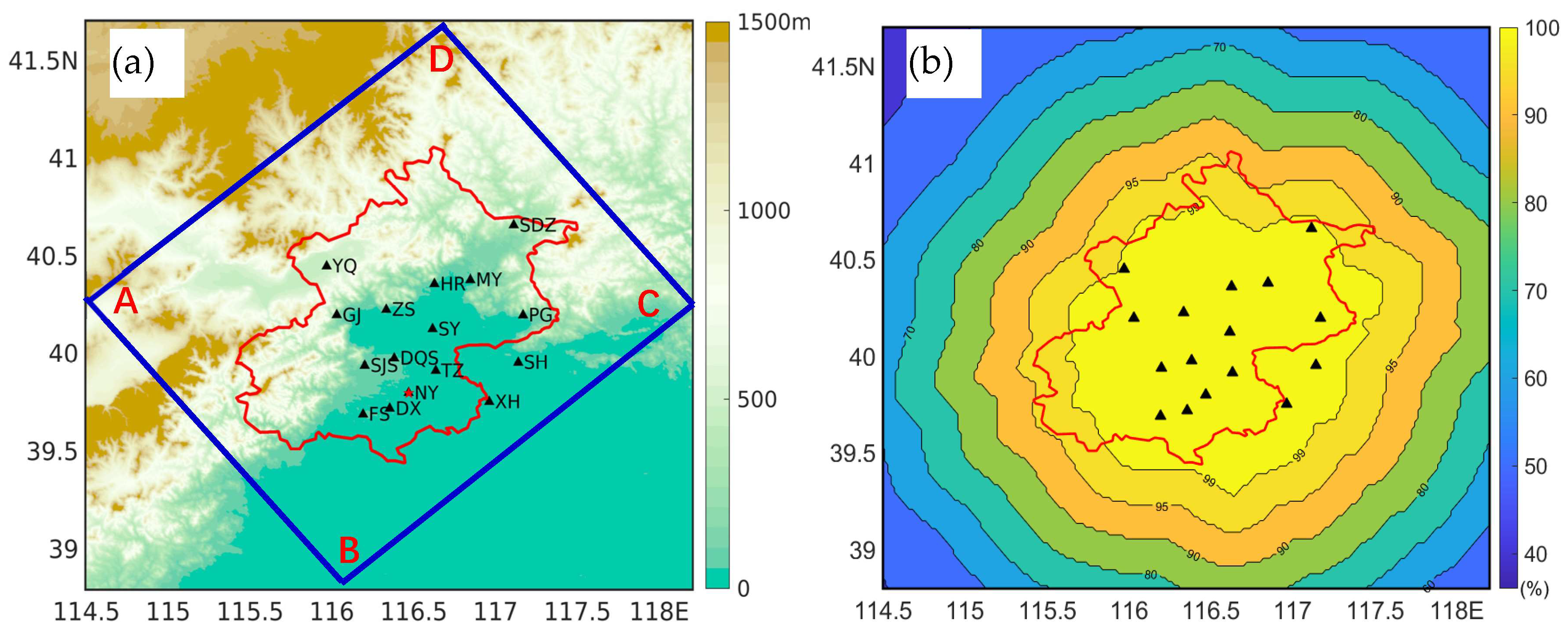




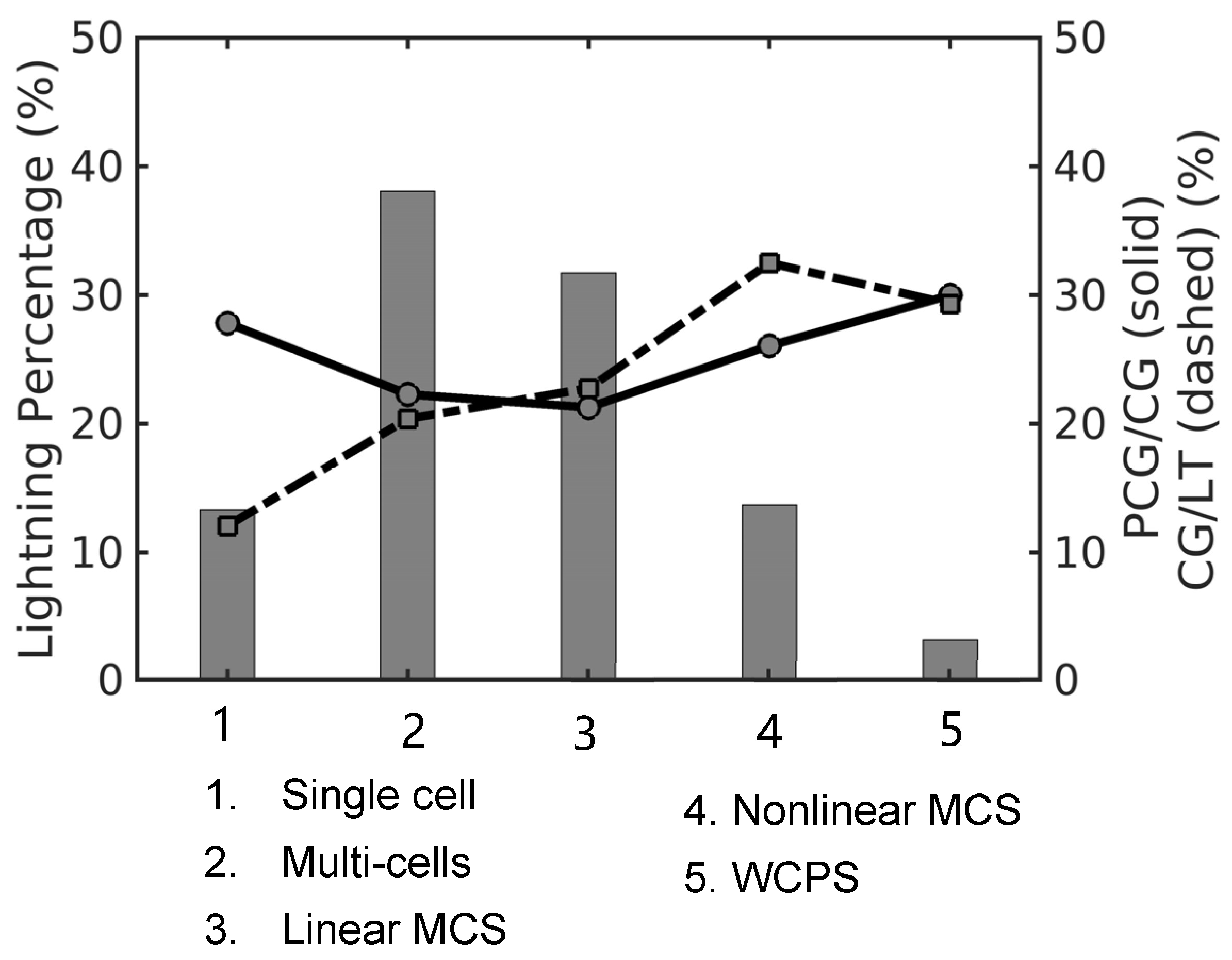
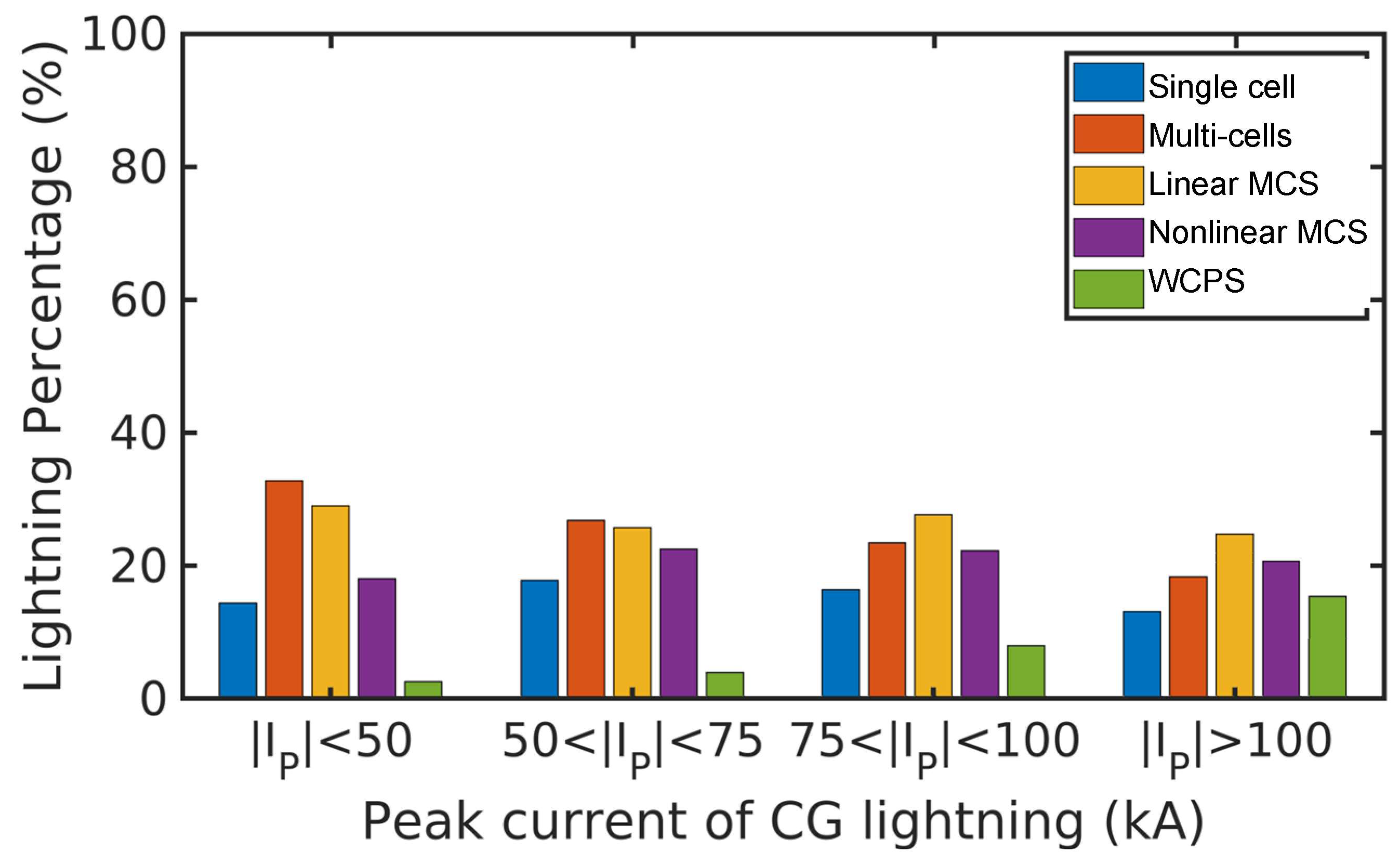

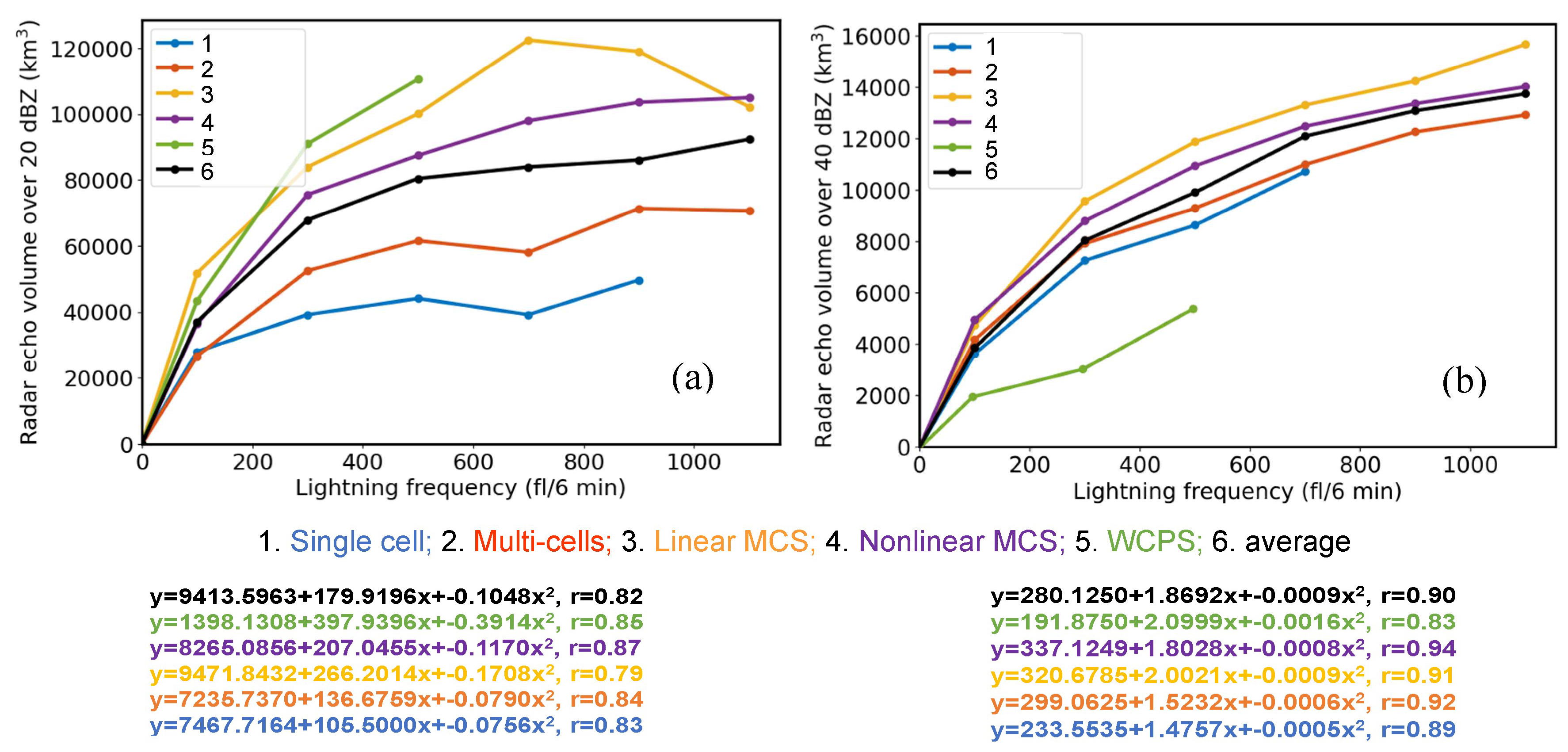
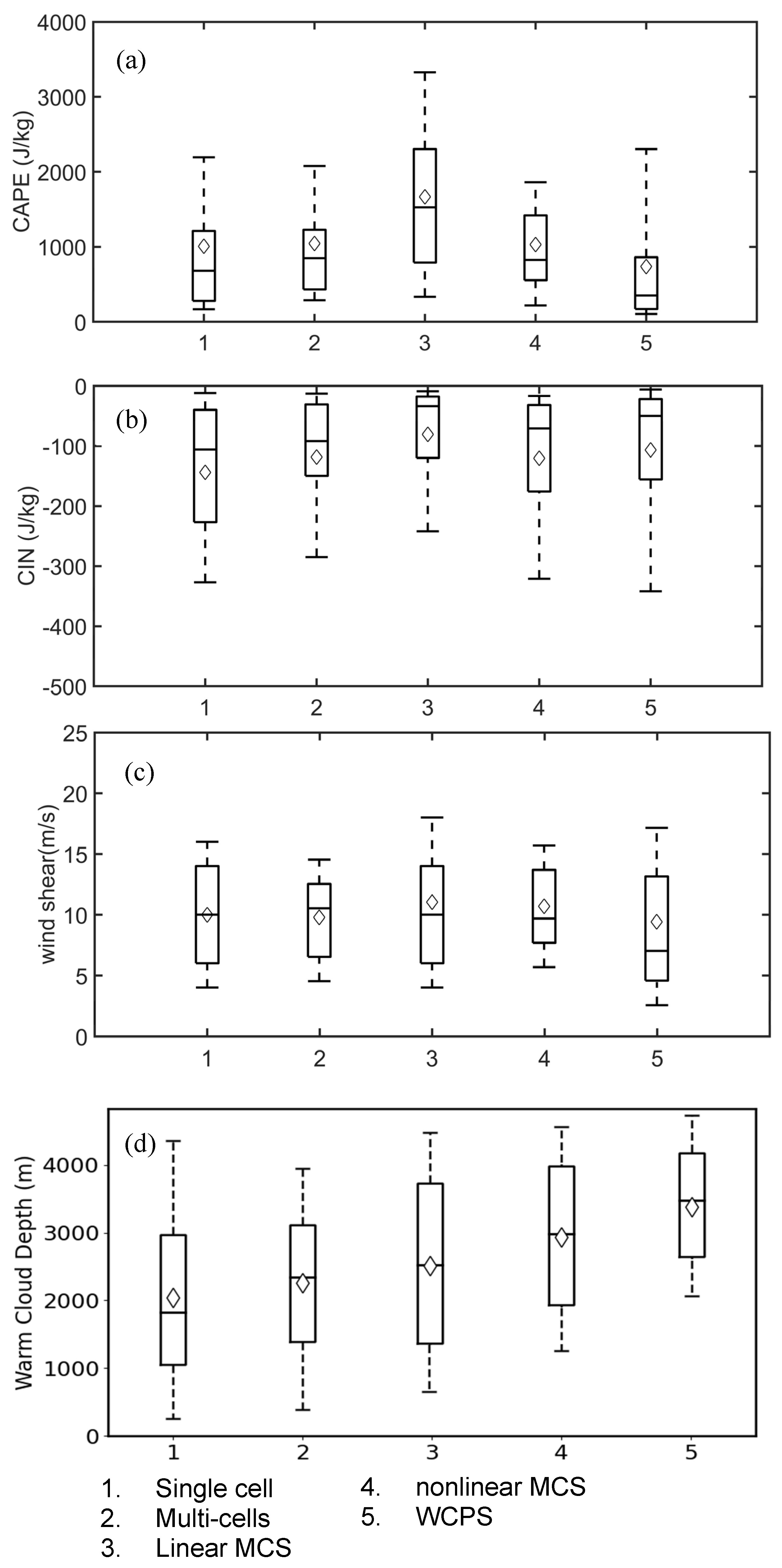
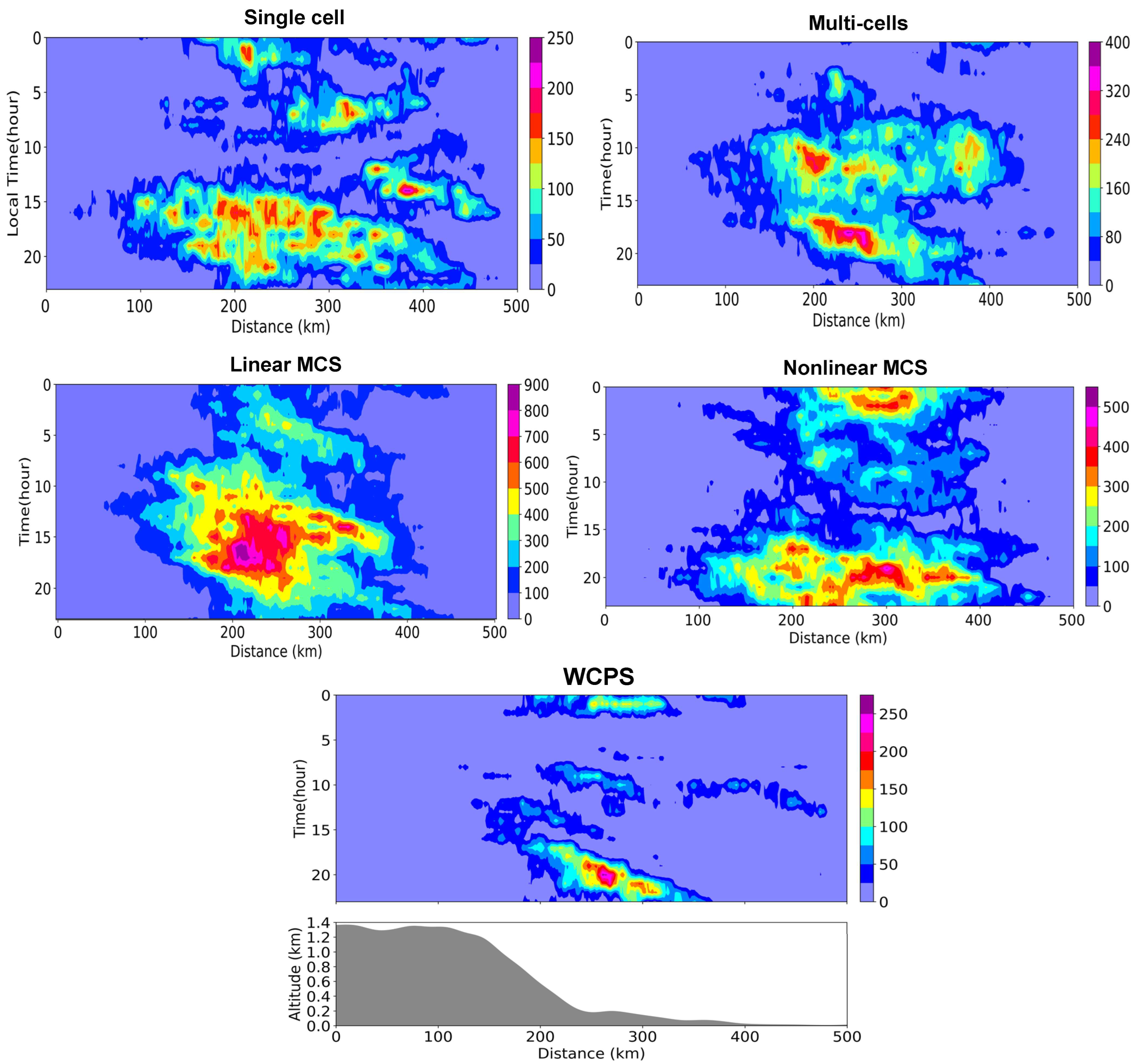
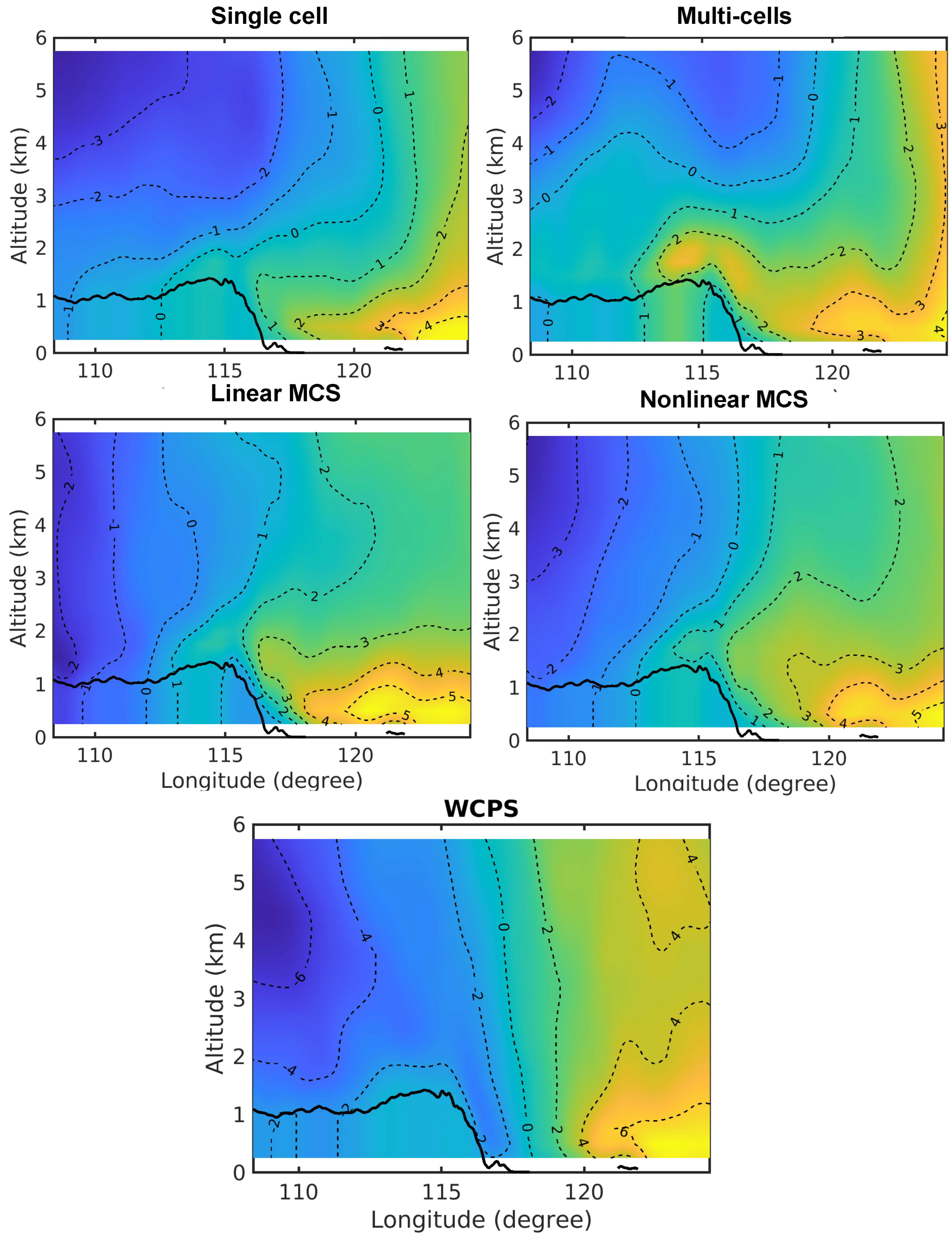
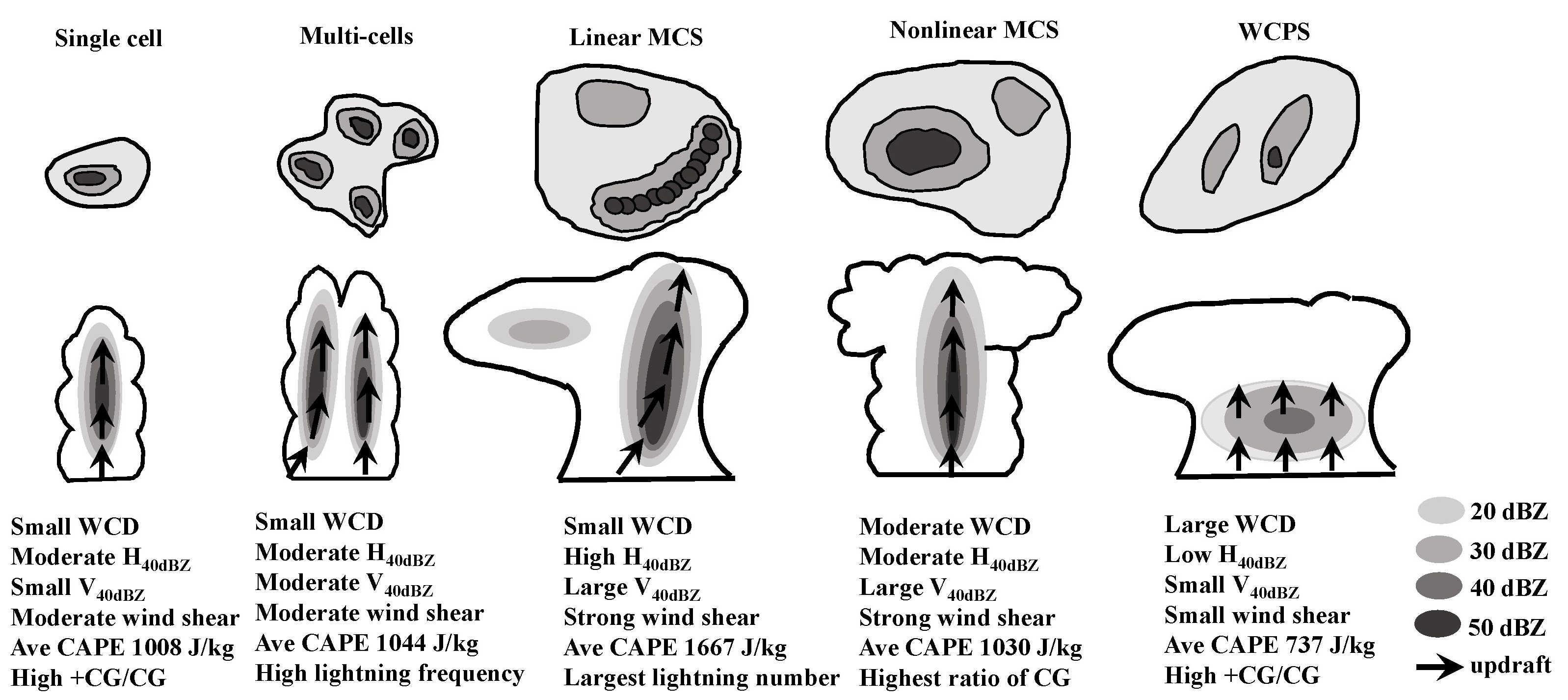
Disclaimer/Publisher’s Note: The statements, opinions and data contained in all publications are solely those of the individual author(s) and contributor(s) and not of MDPI and/or the editor(s). MDPI and/or the editor(s) disclaim responsibility for any injury to people or property resulting from any ideas, methods, instructions or products referred to in the content. |
© 2024 by the authors. Licensee MDPI, Basel, Switzerland. This article is an open access article distributed under the terms and conditions of the Creative Commons Attribution (CC BY) license (https://creativecommons.org/licenses/by/4.0/).
Share and Cite
Liu, D.; Yu, H.; Sun, Z.; Zhang, H.; Wang, D. Convective Properties and Lightning Activity in Different Categories of Thunderstorms over the Beijing Area during Five Warm Seasons. Remote Sens. 2024, 16, 447. https://doi.org/10.3390/rs16030447
Liu D, Yu H, Sun Z, Zhang H, Wang D. Convective Properties and Lightning Activity in Different Categories of Thunderstorms over the Beijing Area during Five Warm Seasons. Remote Sensing. 2024; 16(3):447. https://doi.org/10.3390/rs16030447
Chicago/Turabian StyleLiu, Dongxia, Han Yu, Zhuling Sun, Hongbo Zhang, and Dongfang Wang. 2024. "Convective Properties and Lightning Activity in Different Categories of Thunderstorms over the Beijing Area during Five Warm Seasons" Remote Sensing 16, no. 3: 447. https://doi.org/10.3390/rs16030447
APA StyleLiu, D., Yu, H., Sun, Z., Zhang, H., & Wang, D. (2024). Convective Properties and Lightning Activity in Different Categories of Thunderstorms over the Beijing Area during Five Warm Seasons. Remote Sensing, 16(3), 447. https://doi.org/10.3390/rs16030447





